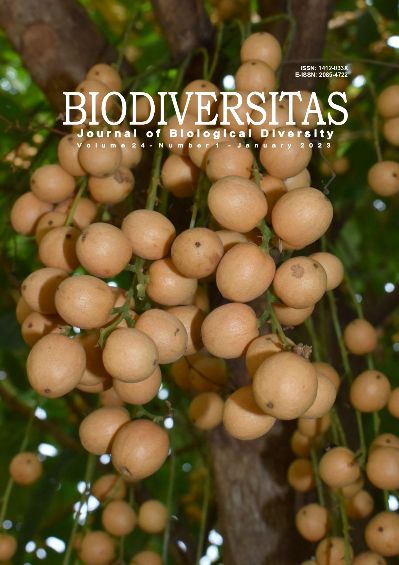Orthoptera (Insecta) fauna of the Kashkadarya region, Uzbekistan
##plugins.themes.bootstrap3.article.main##
Abstract
Abstract. Nurjaniv AA, Medetof MZH, Kholmatov BR, Abdullahyev II, Tufliyev NKH, Nurjonov FA. 2023. Orthoptera (Insecta) fauna of the Kashkadarya region, Uzbekistan. Biodiversitas 24: 112-121. More than 30,000 different species of orthoptera insects, most of which are found in the tropics and subtropics, are known to exist in the world's fauna. The most extensive among the orthopteroids is the order Orthoptera, which includes more than 20,000 species of insects. Most are herbivores, while others are predators or have a mixed diet. Large size, jumping abilities, and open lifestyle make orthopteran characters accessible to many landscapes. Orthopterans play a significant role in the movement of the energy flow as an important link in biocenosis, connecting secondary consumers with producers. Many species of Orthopterans, especially grasshoppers, are dangerous pests of agriculture. Harm is especially noticeable from those locust species, which could make swarms. The research was carried out in various agro and natural landscapes to determine the species composition of orthopteran insects in the Kashkadarya region. A total of 1274 samples were collected from 11 coordinates in 10 different landscapes during the scientific trips. They comprised 657 females (51.4%), 403 males (31.6%), and 214 nymphs (16.7%). The distribution of 70 species belonging to 50 genera and 7 families of orthopteran insects is discussed in this research. Samples were taken from 6 coordinates in 6 types (cucurbits, orchards, alfalfa, mulberry, vineyards, and mung bean fields) of agro-landscapes and 6 coordinates in 4 natural (plains of the Karshi desert, hills, mountains, and saxaul forests) landscapes. The highest species diversity has been found in orchards, where 129 samples of 20 orthopteran species have been collected in the Guzar district of the Kashkadarya region. The Karshi desert was identified as the landscape with the lowest number of species, with 41 samples of 9 species collected. The average density of insects in the desert was 0.4 per square meter. Two species were found in all 12 coordinates of 10 different landscapes, and 11 were found only once in one coordinate.

